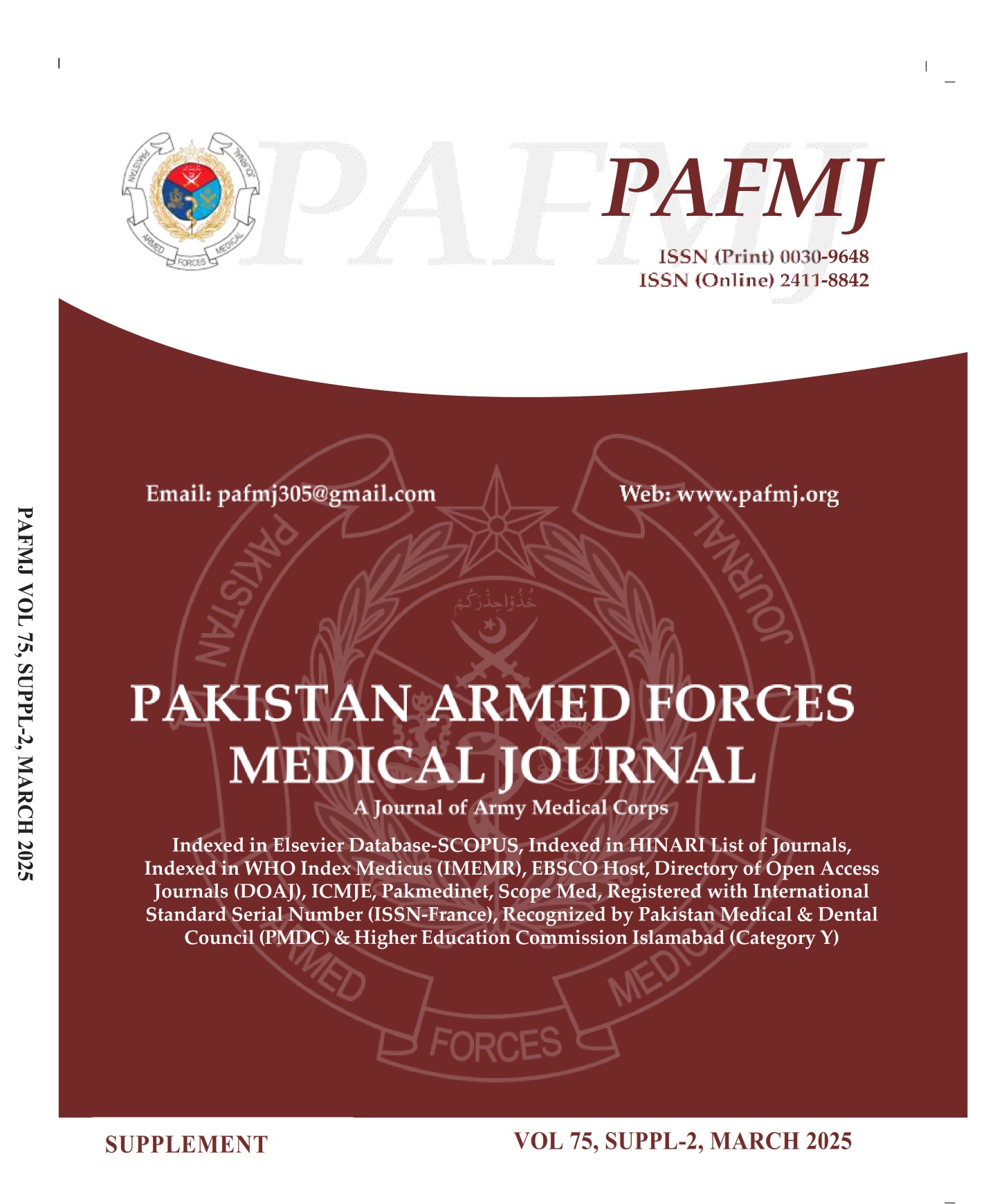Effect of Local Wound Infiltration with Ketamine versus Dexmedetomidine on Post-operative Pain Relief in Terms of Quality and Duration after Cesarean Section
DOI:
https://doi.org/10.51253/pafmj.v75iSUPPL-2.11742Keywords:
Dexmedetomidine, Ketamine, Lower Segment Cesarean Section (LSCS).Abstract
Objective: To measure the frequency of pain and duration of analgesia with two different adjuvants (ketamine & dexmedetomidine) with local anesthetic bupivacaine for local wound infiltration after cesarean section for post-operative analgesia.
Study Design: Randomized Controlled Trial (IRCT: 74668).
Place and Duration of Study: Anesthesia department, Pakistan Air Force Hospital, Karachi Pakistan, from Jul to Dec 2023.
Methodology: The study was commenced after permission from the ethical committee with ERC number FRPMC-IRB-2023-03 & trial registration number#74668 9 (IRCT). It was a single center study and a sample of 142 was randomized into two groups: Groups A and B. In group A ketamine was employed as an adjuvant and in group B dexmedetomidine was used as an adjuvant. Quality of analgesia and duration of block was measured post-operatively in both groups to compare the drug under study.
Results: Twenty-seven (39.7%) of group B patients had mild pain and 41(60.3%) experienced moderate pain at 12 hours. Thirty-nine (54.9%) group A patients developed moderate pain while 32(45.1%) experienced severe pain necessitating rescue analgesia after twelve hours of surgery. The mean time to first rescue analgesia was also prolonged on group B patients with mean duration of analgesia in group B to be 15.49±3.2 hours versus 8.4±4.1 hours in group A with p-value of <0.001.
Conclusion: We concluded that dexmedetomidine was favorable adjuvant in terms of quality and duration of analgesia for local wound infiltration compared to ketamine.
Downloads
References
Buhagiar L, Cassar OA, Brincat MP, Buttigieg GG, Inglott AS, Adami MZ et al. Predictors of post-caesarean section pain and analgesic consumption. J. Anaesthesiol. Clin. Pharmacol 2011; 27(2): 185.
Bjornestad EE, Haney M. An obstetric anaesthetist: A key to successful conversion of epidural analgesia to surgical anaesthesia for caesarean delivery?. Acta Anaesthesiologica Scandinavica 2020; 64(2): 142-144.
Lemoine A, Mazoit JX, Bonnet F. Modelling of the optimal bupivacaine dose for spinal anaesthesia in ambulatory surgery based on data from systematic review. Eur. J. Anaesthesiol 2016; 33(11): 846-852.
Kan A. Classical cesarean section. J. Surg 2020; 6(S02): S98-S103.
Bai JW, An D, Perlas A, Chan V. Adjuncts to local anesthetic wound infiltration for postoperative analgesia: a systematic review. Reg Anesth Pain Med 2020; 45(8): 645-655.
Pan, L., Wu, H., Liu, H. et al. Dexmedetomidine as an adjunct to local anesthetics in nerve block relieved pain more effectively after TKA: a meta-analysis of randomized controlled trials. J Orthop Surg Res 2020; 15: 577-579.
Edinoff AN, Houk GM, Patil S, Siddaiah HB, Kaye AJ, Iyengar PS et al. Adjuvant drugs for peripheral nerve blocks: the role of alpha-2 agonists, dexamethasone, midazolam, and non-steroidal anti-inflammatory drugs. Anesth. Pain. Med 2021; 11(3).
Krishna Prasad GV, Khanna S, Jaishree SV. Review of adjuvants to local anesthetics in peripheral nerve blocks: Current and future trends. Saudi J Anaesth 2020; 14(1): 77-84.
Mohamed SA, Sayed DM, El Sherif FA, Abd El-Rahman AM. Effect of local wound infiltration with ketamine versus dexmedetomidine on postoperative pain and stress after abdominal hysterectomy, a randomized trial. Eur J Pain 2018; 22(5): 951-960.
Ren Y, Wei M, Liu H, Wang Y, Chen H, Li Z, et al. Efficacy and safety of dexmedetomidine as an adjuvant to local wound infiltration anaesthesia: A meta-analysis with trial sequential analysis of 23 randomised controlled trials. Int Wound J 2021; 18(1): 32-48.
Mohamed SA, Sayed DM, El Sherif FA, Abd El‐Rahman AM. Effect of local wound infiltration with ketamine versus dexmedetomidine on postoperative pain and stress after abdominal hysterectomy, a randomized trial. EJP 2018; 22(5): 951-960.
Rizk, R., Refky, M., Zanfaly, H., Ibraheam, A. Postoperative Analgesic Effect of Using Bupivacaine Versus Bupivacaine with Dexmedetomidine or Ketamine in Cesarean Section Operations. EJHM 2022; 88(1): 3374-3379.
Shafshak TS, Elnemr R. The visual analogue scale versus numerical rating scale in measuring pain severity and predicting disability in low back pain. JCR: J Clin Rheumatol 2021; 27(7): 282-285.
Mohamed SA, Sayed DM, El Sherif FA, Abd El‐Rahman AM. Effect of local wound infiltration with ketamine versus dexmedetomidine on postoperative pain and stress after abdominal hysterectomy, a randomized trial. EJP 2018; 22(5): 951-960.
Biomy NR, Fathelbab A, Abdel-Fattah A, Farhat AE. Ketamine versus Dexmedetomidine in Local Wound Infiltration for Postoperative Pain Relief in Cesarean Section. IJMA 2021; 3(3): 1570-1575.
Biomy NR, Fathelbab A, Abdel-Fattah A, Farhat AE. Ketamine versus Dexmedetomidine in Local Wound Infiltration for Postoperative Pain Relief in Cesarean Section. IJMA 2021; 3(3): 1570-1575.
Jiang C, Lv C, Gao J, Li C. Effect of dexmedetomidine combined with local infiltration analgesia on postoperative wound complications in patients with total knee arthroplasty: A meta‐analysis. Int. Wound J 2023; 3(4): 14-21.
Azemati S, Pourali A, Aghazadeh S. Effects of adding dexmedetomidine to local infiltration of bupivacaine on postoperative pain in pediatric herniorrhaphy: a randomized clinical trial. KJA 2020; 73(3): 212-218.
Qiu J, Luo Z. The comparison of dexmedetomidine and ketamine for pediatric dental surgery: A meta-analysis of randomized controlled studies. Medicine (Baltimore) 2019; 98(17): e15068.
Hefni AF, Eldeek AM, Ismael SA, Shaban AR. Comparing Effect of Adding Ketamine Versus Dexmedetomidine to Bupivacaine in Pecs-ⅠⅠ Block on Postoperative Pain Control in Patients Undergoing Breast Surgery. Clin J Pain 2022; 38(9): 568-574
Downloads
Published
Issue
Section
License
Copyright (c) 2025 Zainab Afzal, Zahid Akhtar Rao, Syed Sameuddin, Muhammad Khalid, Muhsan Sultan, Adil Mehraj

This work is licensed under a Creative Commons Attribution-NonCommercial 4.0 International License.















